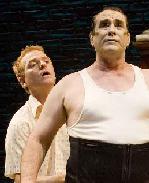SITE GUIDE
SEARCH
REVIEWS
FEATURES
NEWS
Etcetera and
Short Term Listings
LISTINGS
Broadway
Off-Broadway
NYC Restaurants
BOOKS and CDs
OTHER PLACES
Berkshires
London
California
New Jersey
DC
Philadelphia
Elsewhere
QUOTES
TKTS
PLAYWRIGHTS' ALBUMS
LETTERS TO EDITOR
FILM
LINKS
MISCELLANEOUS
Free Updates
Masthead
Writing for Us
A CurtainUp Review
Exits and Entrances
By David Lohrey
|
Haven’t you heard about the terrible going-on in the theatre? The drunkenness? The sexual orgies? (He sighs) If only it were true! How much more fun this would all be!—Andre
|

(L to R) William Dennis Hurley as The Playwright and Morlan Higgins as Andre in Athol Fugard's Exits and Entrances
(Photo: James Leynse) |
Exits and Entrances received its world premiere in Los Angeles at the Fountain Theatre where it won numerous L.A. Ovation Awards and L.A. Drama Critics Circle Awards. It comes to New York under the same able director, Stephen Sachs, and with its superb two-member cast intact. It would be difficult to imagine it ever finding a better production. Morlan Higgins has been given the role of a lifetime as the classical stage actor Andre Huguenet, who was once known as the Olivier of South Africa — an opportunity he fully realizes. He was also the mentor and personal friend of the young Athol Fugard before he became a world-renowned dissident playwright. William Dennis Hurley plays this young Fugard, known only as The Playwright. He too is wonderful even though his function as narrator and active participant is less showy.
Set in Port Elizabeth, South Africa, in 1956 and 1961, the play opens as The Playwright ponders a newspaper article which has announced the once great actor’s unexplained death. We are then taken back to the Andre’s dressing room in 1956 and the period when Fugard worked as the actor’s dresser and go-fer. Hurley, who bears a remarkable resemblance to Fugard in his young days, is an audience of one to Higgins' brilliant and flashy Andre, a grand poseur not unlike Eugene O’Neill’s James Tyrone who also becomes a rather humble and gentle giant like Jackie Gleason. Andre is alternatively pompous and light-hearted, a bear and then quite suddenly a butterfly. There are times when he reminded me of Walt Disney’s dancing hippopotamus in a tutu.
Sachs’ staging is flawless. Charlie Corcoran’s set is simple but apt and is lit to best theatrical effect by Brian Nason. Shon LeBlanc supplies suitable costumes for Andre's excerpted performances which include King Oedipus, the Cardinal in a production of a play called The Prisoner and Hamlet. The physique exposing underwear worn in his dressing room echo the actor's bare everything emotional style.
It is during a backstage visit from The Playwright after Andre's performance as the Cardinal that we see the erstwhile overbearing actor revealed in a different light. His confidence has already been shattered by a series of professional setbacks that finally grind him down and perhaps point to a possible explanation for his death. The young playwright's insistence that he must stick to his ideals — writing about the entire South African population and not just Afrikaaner whites— is a painful reminder of his own long lost youthful ideals.
It is also during that final meeting between the still budding playwright and the actor whose style is no longer appreciated that the play is most alive. Fugard's stand-in is faced with seeing both his father and his mentor as men whose time has come and gone (his father is dying and as his son puts it, though the obituary won't say so, "he's dying of unimportance"). While the fact that Huguenet was gay is not central to the play, Fugard includes it, probably to suggest that the loneliness and burden of living as a gay actor in those repressive times may have ultimately been too much for this proud man to bear. Fugard's main intent, however, was to pay tribute to his first mentor in the world of the theater. Exits and Entrances is his heartfelt acknowledgement of the inspiration gained from the man who was exiting that world just as he was making his entrance as a writer whose words would soon resonate meaningfully throughout the world.
| Exits and Entrances Playwright: Athol Fugard Directed by Stephen Sachs Cast: Morland Higgins as Andre? Huguenet and William Dennis Hurley as The Playwright. Sets: Charlie Corcoran Costumes: Shon Le Blanc Lights: Brian Nason Sound Design: David B. Marling Running Time: 1 hour and 20 minutes, with no intermission The Primary Theatre at 59E59 theaters, 59 East 59th Street, NYC From 3/27/07 to 4/29/07; opening 4/04/07 Tuesdays at 7:00 p.m., Wednesdays through Saturdays at 8:00 p.m., with matinees Wednesdays & Saturdays at 2:00 p.m., and Sundays at 3:00 p.m. In place of the Wednesday matinees on April 18 & 25, Primary Stages is presenting 1pm shows to student groups at no charge, under the auspices of the Primary Stages NYC Public School Student Matinee program. Tickets: $60 Reviewed by David Lohrey, on April 1, 2007 |

Easy-on-the budget super gift for yourself and your musical loving friends. Tons of gorgeous pictures.

Leonard Maltin's 2007 Movie Guide

At This Theater
Leonard Maltin's 2005 Movie Guide

 >
>

